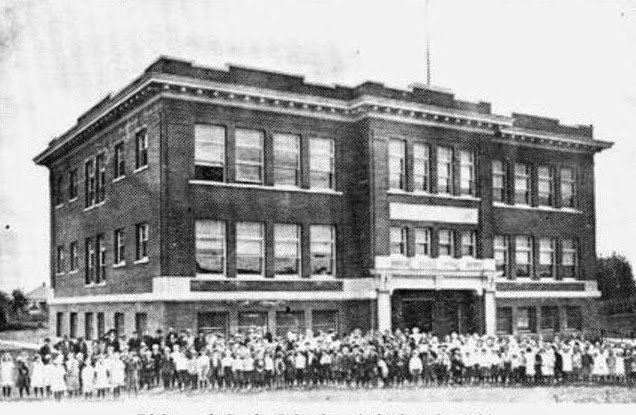- Diplomatic relations with Mexico break down, U.S. Marines land in Veracruz which they will occupy for 6 months.
- Archduke Franz Ferdinand of Austria assassinated. As European nations begin World War I, President Wilson promises to keep America out of the conflict. (He signs a Mother’s Day Proclamation.)
- German trips invade Belgium: The British Empire declares war on the German Empire, including Austro-Hungary, which declares war on Russia. China declares neutrality. Japan extends its influence in China and seizes German territories in the Pacific and East Asia.
- Ford Motor Company establishes a workers’ 8-hour day with a minimum $5 wage.
- Panama Canal opens in Panama with the passage of the SS Ancon, a 1901 steamship that had played a major part in ferrying supplies for canal construction.(The Path Between the Seas, David McCullough, 1977)
- Charlie Chaplin makes his first movie debut with the character of the tramp in “Making A Living”. Mary Pickford’s name appears above the title of film “Hearts Adrift”, beginning the “Star” recognition.
- New American Books: The Titan, Theodore Dreiser; Penrod, Booth Tarkington, The Congo and Other Stories, Vachel Lindsay.
In Salem
William C. Knighton, the official state architect of that time, designed this handsome Supreme Court building costing $320,000. The exterior is finished with cream-colored terra cotta and the interior is marble and tile. At the rear of the ground floor, there is an ornate stairway leading to a handsome columned library. The third floor contains the Court Chambers with a glass skylight that includes a replica of the seal of the state of Oregon.
Former Oregon Chief Justice Wallace Carson, Jr. was honored as the Salem Citizen of the Year 2010 at the Chamber of Commerce banquet February 11, 2011.
When you visit
The building is open to visitors after passing a security officer inside the front door. You will be told whether the upper floors are available for visiting at that time. The beautiful library and courtroom are well worth a visit and you may be able to hear some of the deliberations of the court.
It is easy to see the impact the Oregon State Government has on the life of the city. It provides stable local employment and helps make Salem a destination for many visitors, but also increasingly occupies properties, particularly in the core of the city, for which the city provides services but receives no tax revenue.
Other Events
-
- B. L. Steeves is elected as mayor. The family’s 1926 Dutch Colonial home still stands at 1694 Court Street, however the lawn and trees of the property were lost when 17th Street was widened in the 1960’s. The home was owned and occupied by the family into the second generation. The house next door at 1674 Court Street was built for the Steeves daughter, Muriel. Her family occupied this home until 1960. These properties can be seen on the SHINE Court-Chemeketa Walking Tour.
- The Roberts Store is established south of Salem and a farming community (complete with train stop) grew up around it. The store remained open until a recent closure (the photograph was taken in 2008), then opened again. The school was put to other uses and the abandoned church collapsed.
- The local YWCA is started in the spring of 1914 with Mrs. C.K. Spaulding heading the board. The organization’s headquarters were in the Knight home on North Liberty Street and the Salem Women’s club made the arrangements and gift of money which made the organization possible. An excerpt from the front page of the Daily Oregon Statesman on April 1, 1914 says, “Salem business men have heartily endorsed the organization plan and have promised to assist in any manner possible should the association care to call on them”.
-

Richmond School in its first year, 1914 Students of the new Richmond School pose for a photograph.
- Two years after the completion of the new Carnegie Library on State Street, the city takes over financial responsibility for this cultural institution. The Salem Public Library Advisory Board (our first Advisory Board) is created with members appointed by the mayor and councilors. The nine members presently meet at the library with the Director on second Wednesday of each month at 7 pm. The public is welcome.
- Another public structure, the Mt. Crest Mausoleum, was completed this year. The architect was Ellis Lawrence who designed the Mahonia Hall, Elsinore Theater and other Salem structures. The building has been added to 9 times, have 6 governors interred there and a number of other prominent people of Salem through out the years. It is a part of City View Cemetery, just to the west of Pioneer Cemetery, sharing a fence.
- April 18 on this year, John Zachary began serving an indeterminate sentence of three to twenty years in the Oregon State Penitentiary. He did not survive his sentence, dying in the prison hospital on November 27, 1915. He is buried a short distance from his great-grandmother, Tabitha Brown, in Pioneer Cemetery. His widow, Maud Hill Zachary, moved to Front Street with their five children, making a living as a laundress.
From the Capitol Journal:
- Governor Oswald West made an official visit to Washington, D. C. and the round trip cost the state of Oregon just $1.50. In New York, Governor West made a speech for which he was paid $375. This he turned over to Secretary of State Ben Olcott when he filed his expense account. The state’s share of $1.50 was the cost for the governor’s travel between Salem and Portland.
- Benjamin S. Via and C. L. Imus, sponsors of the organization of a cavalry troop in Salem to participate in a possible war with Mexico, said they had their quota signed up and were ready for a call by the proper authorities.
- In December, “Old Tiger”, the fire engine that had seen service in Salem for many years, was taken to Willamette Slough to pump water on the ice and make the surface smooth for skaters.
(See Ben Maxwell’s Salem, Oregon, edited by Scott McArthur, 2006.


2 Comments